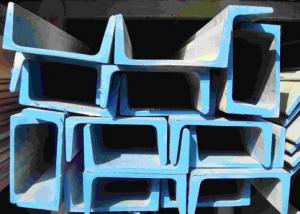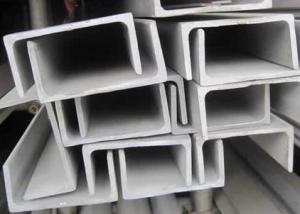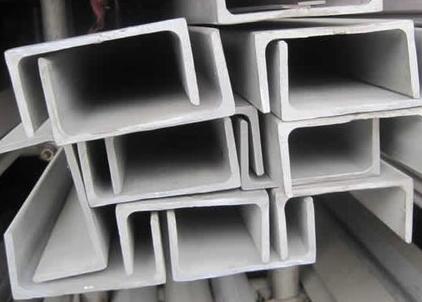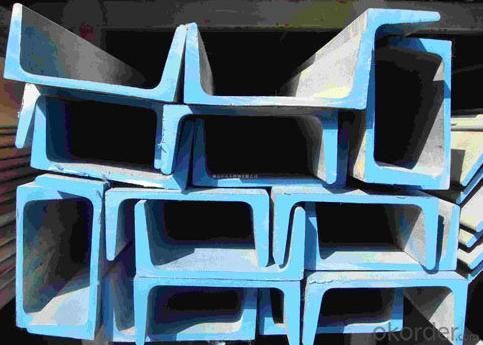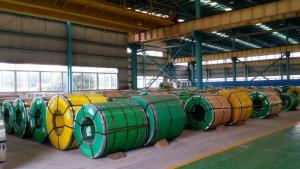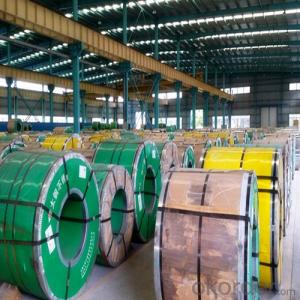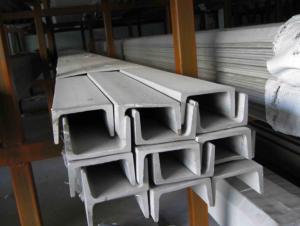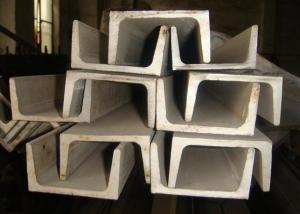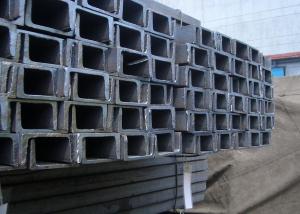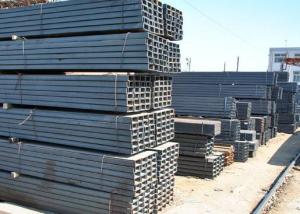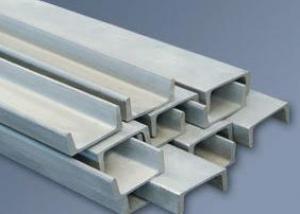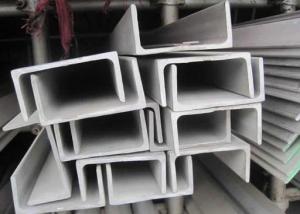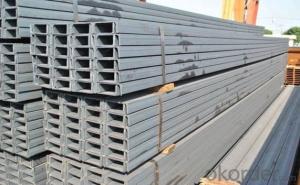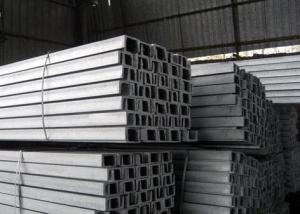201 Stainless Steel Channels
- Loading Port:
- China Main Port
- Payment Terms:
- TT or LC
- Min Order Qty:
- 5 Tons m.t.
- Supply Capability:
- 1000 Tons Per Month m.t./month
OKorder Service Pledge
OKorder Financial Service
You Might Also Like
Stainless Steel Channel
1.Size: 3mm to 24mm Thickness
2.Material:SUS201,202,301,304,304L,316,316L ,321 etc.
3.Length: 4m to 6m,or according to the customer's requirement
4.Standard: AISI,JIS,GB,DIN
5.Finish: Cold Drawn ,hot rolled & Polishing
6.Testing: Each heat number and batch must be tested for both chemical and mechanical properties
7.Application: Produce screw and nut, engine parts, indoor and outdoor decorating,etc.
|
Size (mm) |
Thickness (mm) | ||||||||
|
H×B |
3 |
4 |
5 |
6 |
7 |
8 |
9 |
10 |
12 |
|
Mass (Kg/m) | |||||||||
|
40×20 |
1.79 |
|
|
|
|
|
|
|
|
|
50×25 |
2.27 |
|
|
|
|
|
|
|
|
|
60×30 |
2.74 |
3.56 |
4.37 |
5.12 |
|
|
|
|
|
|
70×35 |
3.23 |
4.21 |
5.17 |
6.08 |
|
|
|
|
|
|
80×40 |
3.71 |
4.84 |
5.96 |
7.03 |
|
|
|
|
|
|
90×45 |
4.25 |
5.55 |
6.83 |
8.05 |
|
|
|
|
|
|
100×50 |
4.73 |
6.18 |
7.62 |
8.98 |
10.3 |
11.7 |
13 |
41.2 |
|
|
120×60 |
|
|
9.2 |
10.9 |
12.6 |
14.2 |
|
|
|
|
130×65 |
|
|
10.1 |
11.9 |
13.8 |
15.5 |
17.3 |
19.1 |
|
|
140×70 |
|
|
|
12.9 |
14.9 |
16.8 |
18.8 |
20.7 |
|
|
150×75 |
|
|
|
13.9 |
16 |
18.1 |
20.2 |
22.2 |
26.3 |
|
160×80 |
|
|
|
14.8 |
17.1 |
19.3 |
21.6 |
23.8 |
28.1 |
|
180×90 |
|
|
|
16.7 |
19.4 |
22 |
24.5 |
27 |
32 |
|
200×100 |
|
|
|
18.6 |
21.6 |
24.5 |
27.4 |
30.2 |
35.8 |
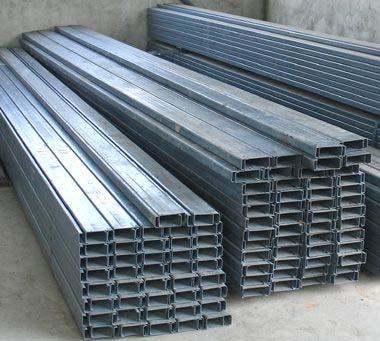
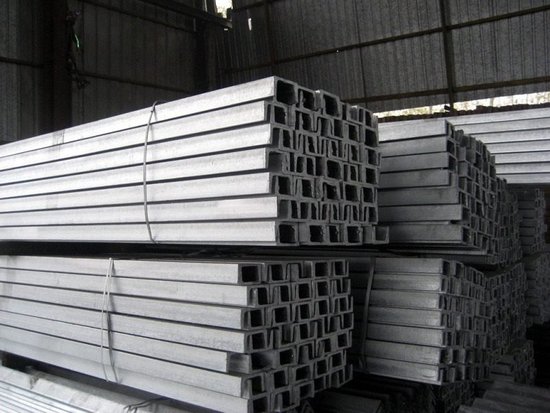
- Q:Can stainless steel channels be used for recreational or sports facilities?
- Stainless steel channels are indeed applicable to recreational or sports facilities. Given its durability and resistance to corrosion, stainless steel proves to be a fitting choice for environments that encounter moisture, chemicals, and high impact situations. These channels can serve numerous purposes within recreational or sports facilities, including handrails, guardrails, bleachers, and equipment supports. Furthermore, stainless steel channels present the advantage of being easy to clean and maintain, ensuring a hygienic and secure atmosphere for users. Their sleek and contemporary appearance also contributes aesthetic value to the facilities. In summary, stainless steel channels offer a dependable and enduring solution for recreational or sports facilities.
- Q:Can stainless steel channels be used for balcony supports?
- Yes, stainless steel channels can be used for balcony supports. Stainless steel is a strong and durable material that is resistant to corrosion, making it an excellent choice for outdoor applications like balcony supports. Its high strength-to-weight ratio and aesthetic appeal also make it a popular choice among architects and engineers for structural elements.
- Q:Are stainless steel channels suitable for industrial walkways?
- Industrial walkways are well-suited to the use of stainless steel channels. Renowned for its exceptional strength, durability, and resistance to corrosion, stainless steel proves to be an excellent choice for industrial applications. Ensuring safety for both workers and equipment, stainless steel channels offer structural support and stability for walkways. Moreover, stainless steel is effortless to clean and maintain, a critical factor in maintaining cleanliness within industrial environments. With its non-slip characteristics and capacity to withstand heavy loads, stainless steel channels emerge as a dependable option when it comes to industrial walkways.
- Q:What are the different surface treatment options available for stainless steel channels?
- Stainless steel channels can be treated in various ways to achieve different benefits and enhance their overall appearance and performance. Some commonly used surface treatments for stainless steel channels are as follows: 1. Polishing: By using abrasive materials, imperfections and roughness on the surface of stainless steel channels can be removed, resulting in a smooth and glossy finish that enhances the material's aesthetics. 2. Passivation: This chemical treatment eliminates surface contaminants and forms a thin protective layer on stainless steel channels. It helps prevent corrosion, improves resistance to staining and discoloration, and enhances the material's overall durability. 3. Electropolishing: In this treatment, stainless steel channels are immersed in an electrolyte solution and subjected to an electric current to eliminate surface metal. The result is a smooth, shiny, and clean surface that further enhances the material's ability to resist corrosion. 4. Powder Coating: This technique involves electrostatically applying a dry powder to the surface of stainless steel channels, which is then heated to form a protective layer. Powder coating offers excellent durability and resistance to abrasion, chemicals, and UV radiation. 5. PVD Coating: Physical Vapor Deposition is a process where a thin layer of metal is deposited onto stainless steel channels using a vacuum chamber. This treatment provides various color options, enhances wear resistance, and adds a decorative finish to the material. 6. Brushed Finish: By using abrasive materials, a textured or matte finish can be created on the surface of stainless steel channels. This treatment masks imperfections and gives the material a unique and distinctive appearance. 7. Bead Blasting: This treatment involves propelling small abrasive particles at high velocity against the surface of stainless steel channels. It creates a uniform and matte finish, which is ideal for applications where a non-reflective surface is desired. Each of these surface treatment options for stainless steel channels offers specific advantages depending on the desired outcome, such as improved aesthetics, corrosion resistance, durability, or enhanced performance in specific environments. It is crucial to consider the specific application requirements and seek professional advice to determine the most suitable surface treatment option for stainless steel channels.
- Q:How do stainless steel channels compare to aluminum channels?
- Stainless steel channels and aluminum channels are both commonly chosen for various applications, but they differ in several key aspects. One notable distinction lies in their ability to resist corrosion. Stainless steel channels are renowned for their exceptional corrosion resistance, making them suitable for outdoor or high-humidity settings. They can withstand exposure to moisture, chemicals, and even saltwater without rusting or deteriorating. Conversely, aluminum channels are less corrosion-resistant and may necessitate additional protective coatings or regular maintenance to prevent corrosion. Another factor to consider is their strength and durability. Stainless steel channels are considerably stronger than aluminum channels and have a higher weight-bearing capacity. This makes stainless steel channels the preferred option for structural applications or heavy-duty projects where strength is paramount. Aluminum channels, although lighter in weight, are not as sturdy or long-lasting, making them better suited for lighter applications like trim or decorative purposes. Cost is another aspect worth comparing. Stainless steel channels generally have a higher initial cost compared to aluminum channels. Nevertheless, they offer a longer lifespan and require less maintenance, resulting in long-term cost savings. Aluminum channels are more affordable upfront, but they may require more frequent replacements or repairs due to their lower durability. Lastly, aesthetic appeal is an important consideration. Stainless steel channels boast a sleek and modern appearance, often used in contemporary designs that desire a clean and polished look. Aluminum channels can also be visually appealing, but they may lack the same level of sophistication as stainless steel. In summary, stainless steel channels excel in corrosion resistance, strength, and durability compared to aluminum channels. However, aluminum channels are more cost-effective initially and may be suitable for lighter applications. Ultimately, the choice between stainless steel and aluminum channels depends on the specific project requirements, budget limitations, and aesthetic preferences.
- Q:What are the different load distribution techniques for stainless steel channels?
- Some of the different load distribution techniques for stainless steel channels include using evenly spaced supports or brackets along the length of the channel, using multiple channels in parallel to distribute the load, and using additional reinforcement such as stiffeners or ribs to enhance load distribution.
- Q:Are stainless steel channels suitable for outdoor sculpture installations?
- Undoubtedly, stainless steel channels are suitable for installations of outdoor sculptures. Renowned for its durability and resistance to corrosion, stainless steel proves to be an ideal material for outdoor use. It has the ability to endure diverse weather conditions, such as rain, snow, and sunlight, without rusting or deteriorating. Hence, stainless steel channels emerge as a reliable option for sculptures intended for outdoor display. Moreover, stainless steel possesses a sleek and contemporary appearance that can enhance the aesthetics of the sculpture and harmonize with the surrounding environment. Its robustness and stability also render it suitable for supporting and structuring larger sculptures. In summary, stainless steel channels combine strength, durability, and aesthetic appeal, making them an outstanding choice for outdoor sculpture installations.
- Q:What are the different methods of surface cleaning for stainless steel channels?
- Some different methods of surface cleaning for stainless steel channels include wiping with a damp cloth, using a mild detergent mixed with water and scrubbing with a soft brush, using a stainless steel cleaner or polish, or using a vinegar and water solution.
- Q:Can stainless steel channels be used for framing safety barriers or guardrails?
- Yes, stainless steel channels can be used for framing safety barriers or guardrails. Stainless steel is a strong and durable material that is resistant to corrosion, making it ideal for outdoor applications where guardrails or safety barriers are frequently exposed to harsh weather conditions. Additionally, stainless steel channels provide structural support and can be easily customized to meet specific design requirements. Their versatility and strength make them an excellent choice for framing safety barriers or guardrails, ensuring the safety and security of individuals in various settings such as highways, construction sites, or industrial facilities.
- Q:What are the common applications of stainless steel channels?
- Due to their unique properties, stainless steel channels are utilized in various industries for a multitude of applications. The following are some common uses of stainless steel channels: 1. Construction: The construction industry widely employs stainless steel channels for structural support and framing. They are commonly utilized in the creation of buildings, bridges, and infrastructure projects, owing to their exceptional strength and durability, which make them suitable for heavy-duty tasks. 2. Manufacturing: Stainless steel channels play a significant role in manufacturing processes. They are frequently utilized as support structures for conveyors, shelves, and factory equipment. These channels' corrosion resistance ensures longevity and reduces the need for maintenance, making them ideal for industrial environments. 3. Architectural applications: Stainless steel channels are often incorporated into architectural projects due to their aesthetic appeal and durability. They can serve as decorative trims, handrails, and balustrades in commercial and residential buildings. The sleek and modern design of these channels enhances the overall appearance of the structure. 4. Automotive industry: The automotive industry relies heavily on stainless steel channels, which are used in the construction of vehicle frames, chassis, and body structures. The high strength-to-weight ratio of these channels provides structural integrity while reducing the overall weight of the vehicle. 5. Marine applications: Stainless steel channels are highly resistant to corrosion, making them well-suited for marine applications. They are commonly utilized in the construction of boats, shipbuilding, and offshore structures. The channels' ability to withstand harsh environments and exposure to saltwater ensures longevity and reliability. 6. Food and beverage industry: The food and beverage industry extensively employs stainless steel channels due to their hygienic properties. They are utilized in the construction of processing equipment, storage tanks, and food preparation surfaces. Stainless steel channels are easy to clean, resistant to bacterial growth, and do not react with food or beverages. 7. Pharmaceutical industry: The pharmaceutical industry prefers stainless steel channels for their cleanliness and corrosion resistance. They are utilized in the construction of equipment and cleanrooms, where maintaining a sterile environment is of utmost importance. The smooth surface of these channels prevents particle accumulation and ensures compliance with strict industry standards. In conclusion, stainless steel channels find wide-ranging applications in the construction, manufacturing, architecture, automotive, marine, food and beverage, and pharmaceutical industries. Their strength, durability, aesthetics, and corrosion resistance make them a versatile choice for various structural and functional purposes.
1. Manufacturer Overview |
|
|---|---|
| Location | Jiangsu, China |
| Year Established | 2010 |
| Annual Output Value | above US$8 million |
| Main Markets | East Asia, Middle East, West Europe |
| Company Certifications | |
2. Manufacturer Certificates |
|
|---|---|
| a) Certification Name | |
| Range | |
| Reference | |
| Validity Period | |
3. Manufacturer Capability |
|
|---|---|
| a)Trade Capacity | |
| Nearest Port | Shanghai |
| Export Percentage | |
| No.of Employees in Trade Department | above 50 people |
| Language Spoken: | English, Chinese, Arabic |
| b)Factory Information | |
| Factory Size: | about 15000 square meter |
| No. of Production Lines | above 4 |
| Contract Manufacturing | OEM Service Offered,Design Service Offered |
| Product Price Range | Average |
Send your message to us
201 Stainless Steel Channels
- Loading Port:
- China Main Port
- Payment Terms:
- TT or LC
- Min Order Qty:
- 5 Tons m.t.
- Supply Capability:
- 1000 Tons Per Month m.t./month
OKorder Service Pledge
OKorder Financial Service
Similar products
New products
Hot products
Hot Searches
Related keywords
